Europe Retail Automation Market Size
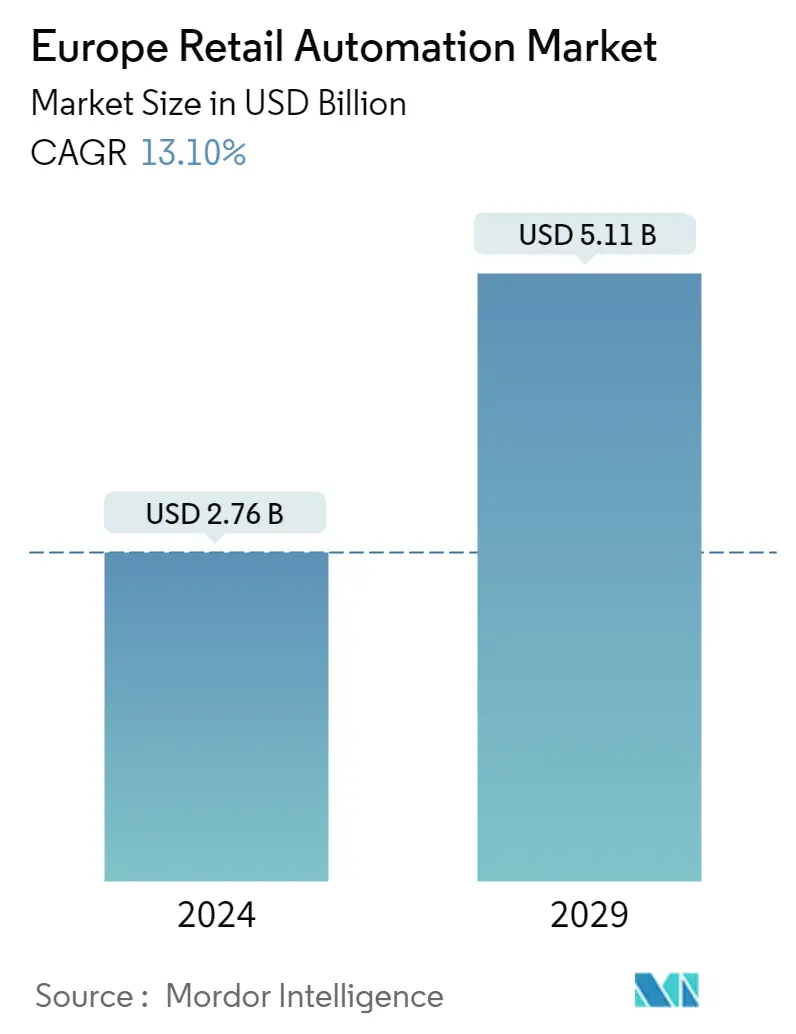
| Study Period | 2019 - 2029 |
| Base Year For Estimation | 2023 |
| Market Size (2024) | USD 2.76 Billion |
| Market Size (2029) | USD 5.11 Billion |
| CAGR (2024 - 2029) | 13.10 % |
| Market Concentration | Medium |
Major Players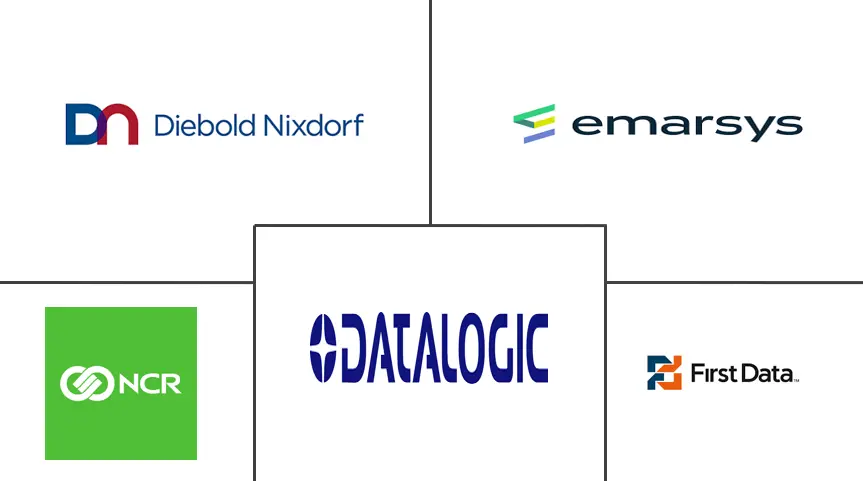
*Disclaimer: Major Players sorted in no particular order |
Europe Retail Automation Market Analysis
The Europe Retail Automation Market size is estimated at USD 2.76 billion in 2024, and is expected to reach USD 5.11 billion by 2029, growing at a CAGR of 13.10% during the forecast period (2024-2029).
- Due to rising inflation, consumers adjusted by spending less, turning to recommerce, and adapting to substitutes. According to Insee, Monthly household expenditure on consumer goods in France decreased from 48.9 thousand USD in January 2021 to 44.9 thousand USD in January 2022. The retailers recognized the need for automation after observing the increase in footfall.
- The European Union has established a forward-looking goal for AI. By 2030, 75% of European businesses will reportedly use AI. The framework puts a lot of emphasis on introducing various cross-border projects, combining EU funding with national governments and private investors. Cloud computing, big data, and AI will be utilized by three out of every four businesses by 2030. The proportion of unicorns in the European Union should treble, and more than 90% of SMEs should achieve at least a basic level of digital intensity.
- March 2022 - To improve its logistics and inventory infrastructure, MQ Marqet, a Swedish fashion retailer, adopted AutoStore, an automated goods-to-person developed by DB Schenker. The system uses warehouse robots to deliver and retrieve bins for operators. The application also takes care of e-commerce and store-replenishment operations.
- During the early stages of the COVID-19 pandemic, when there was a labor shortage, delivery slots were few, and customer demand was high, demand for click-and-collect models surged. These models assisted grocery stores in reaching customers outside urban areas, including suburbs, small communities, and even rural locations. Ocado developed grocery-picking robots that will enable cheaper, quicker deliveries and help with labor shortages.
Europe Retail Automation Market Trends
Grocery Retailers are Expected to Hold a Significant Market Share
- Automated warehousing can track stock levels, which helps Grocery retailers prevent stock shortages and delays. Europen Grocers are adopting AI for in-store technology trends like biometric checkout and scan-and-go systems. In the UK, the first cashier-less store was opened with the help of Amazon's "Just Walk Out" system. As per the system, while entering the store, the customer will scan a code linked to his Amazon account, and the moment he exits the store, payment will be deducted automatically. This way, customers can escape long queues at the billing counter and save time.
- According to a survey by Gartner, 80% of business leaders believe that automation can be used to make strategic decisions. Nearly one-third of companies are applying AI technologies in their businesses.
- In November 2022, AutoStore launched PickUpPort robotic assistance for consumers to shop online and pick up their orders directly from the AutoStore System. A controller function instructs the AutoStore robot to choose the product bins when a consumer orders online and selects in-store pickup. The order is consolidated by the warehouse employee and entered into the AutoStore System. When the customer enters the store, a robot will transport the container containing the appropriate goods to the PickUpPort. This will save customers time, and the store staff can leave once their shift ends instead of waiting for the customer to pick up the order.
- In February 2023 - Goosemoor adopted the Chefserve ERP solution. Chefserve ERP solution is an application developed by Affinitus that will help the retailer manage its financial operations and services, including a delivery order. The ERP solution offers various services like managing delivery routes, vehicle tracking, drop sequence, and online track of rejections and returns.
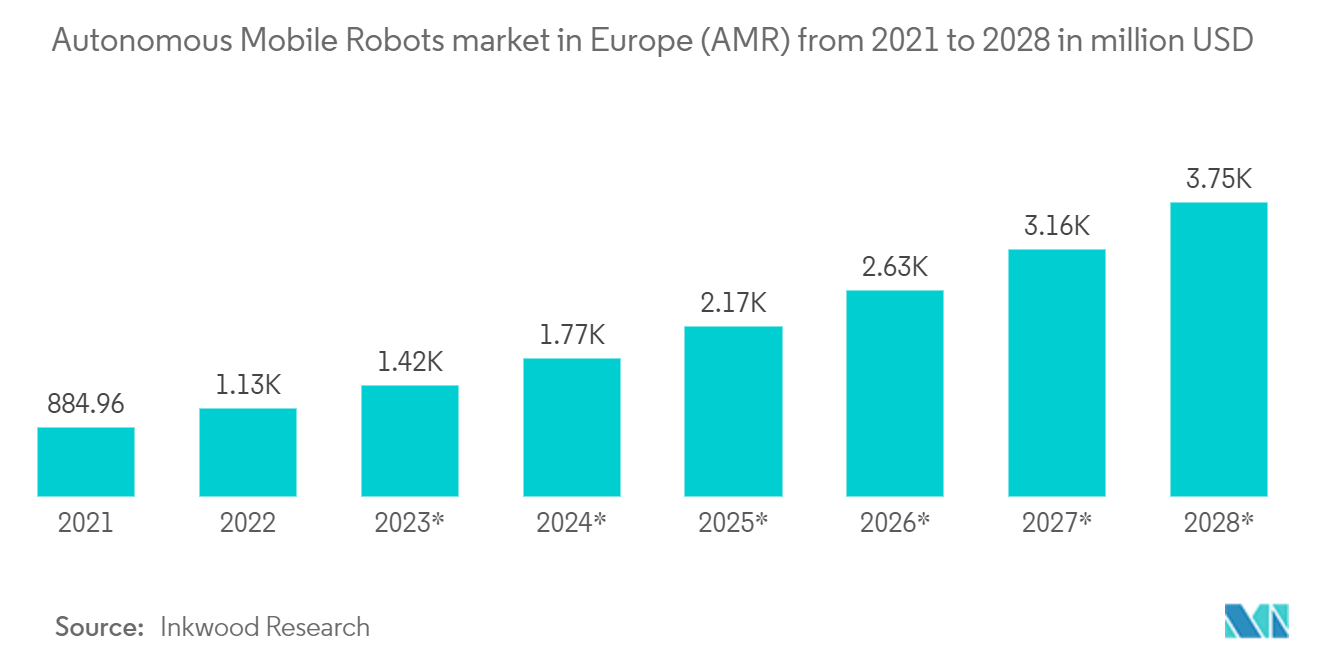
France Accounts for the Largest Market Share
- Compared to other countries, French people shop at supermarkets more frequently and don't buy in quantity. This is so because French rentals have smaller refrigerators, and fresh ingredients are a must in French cooking. Grocery stores in France remain closed on Sundays and usually operate from 7.30 AM to 8 PM on weekdays. People try to finish their groceries on Saturday and go for a fresh purchase, resulting in long queues at the stores. Many retailers are adapting to AI technologies to automate their business framework to manage this traffic and align the smooth working of the stores.
- In November 2022, Intermarché automated its online business by using Micro Fulfillment Centers (MFCs). Intermarché is a food retailer in French that delivers everyday groceries. The increase in online ordering urged the retailer to automate its workflow. MFCs are proficient in serving customers in urban areas, and about 80 % of the Intermarché's order fulfillment occurs at these MFCs.Customers get the option of home delivery, drive-in pickup or having their orders stored in a locker at the store of their choice, where they may pick them up whenever they choose, day or night.
- In June 2022, Delipop and Monoprix joined to provide fully automated e-grocery pickup. Delipop is a network of stores that has collaborated with different stores and offers to pick up groceries from buyers' favorite merchants. Picking up groceries at Delipop reduces 92.5% of kilometers traveled and 77% of C02 emissions compared to the home delivery service.
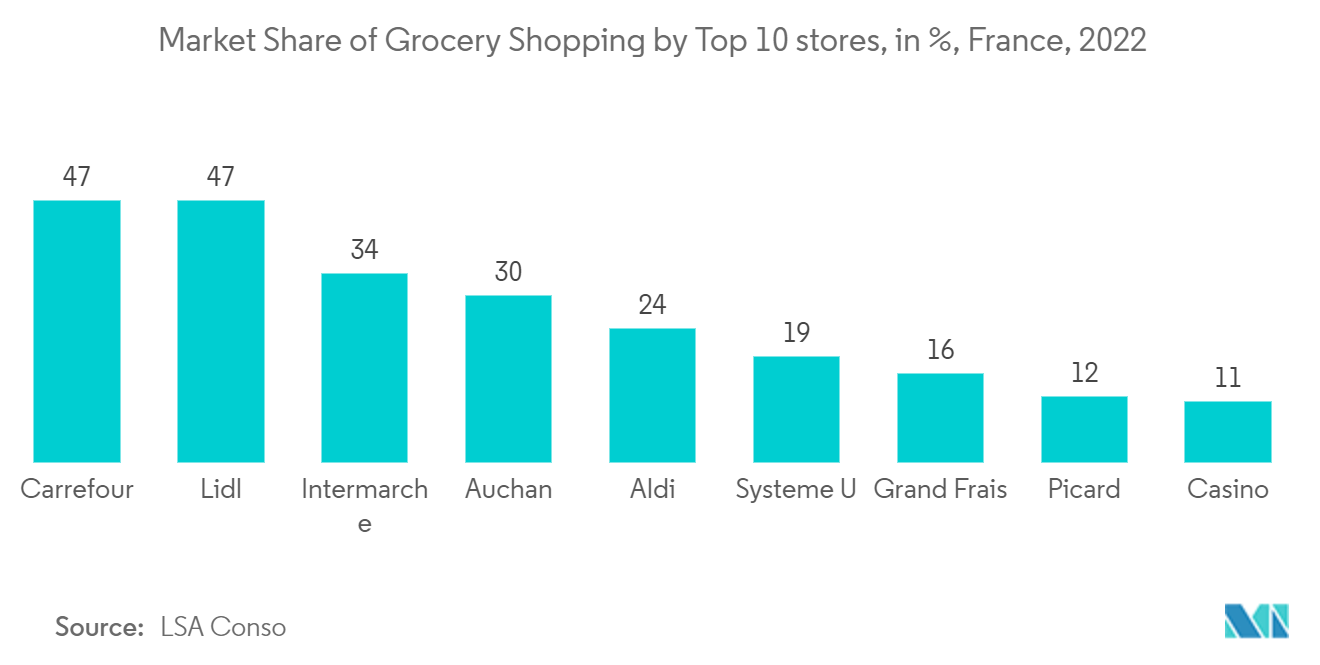
Europe Retail Automation Industry Overview
The European retail automation market is moderately competitive. Retailers are making significant investments in AI and IoT technology to automate their business framework and achieve time by reducing manual interventions. However, the market is dominated by players such as Datalogic, Toshiba Global Commerce, Fujitsu Limited, and so on. These automation providers collaborate with retailers to automate their business framework and achieve profitability.
- September 2022 - With the help of KNAPP Smart Solutions in-store technology, EDEKA could operate its store 24x7. Around 500 SKUs are available in the selection, which may be ordered through the 24/7 Edeka app or in-store terminals. Payment can be made online or through a card swipe. The software tracks the information about where the products are placed and uses it for fully automated product distribution. As a result, systemic shrinkage and inaccurate stock levels are not feasible.
- September 2022 - Fnac Darty, a European consumer electronics retailer, joined SES-image tag, which provides digital solutions for retail stores. The Vusion platform, developed by the SES-image tag, will help Fnac Darty to connect all its store's electronic labels to the cloud. The brand will adopt this technology for its 110 stores across France. The platform will allow Fnac Darty to adopt flexible and dynamic price automation and synchronization across all sales channels.
- August 2022 - Europe's fashion retailer C&A partnered with mParticle to manage its business infrastructure and to assist in understanding the customers' engagement. C&A has numerous customer interaction channels, including physical stores, the internet, and social media. Combining client data from these touchpoints will give the company a closer view of its customer expectations.
Europe Retail Automation Market Leaders
-
Datalogic SpA
-
Emarsys eMarketing Systems AG
-
Diebold Nixdorf Incorporated
-
First Data Corporation
-
NCR Corporation
*Disclaimer: Major Players sorted in no particular order
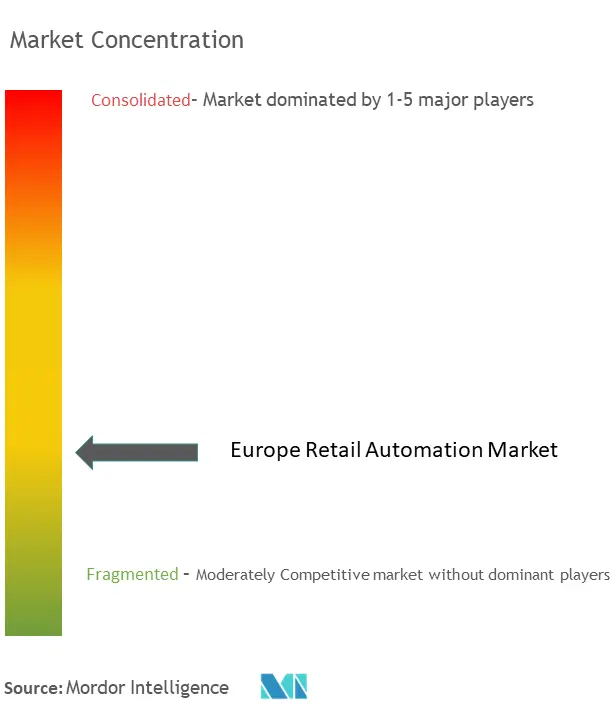
Europe Retail Automation Market News
- January 2023 - Currys, the UK-based retailer, partnered with a digital display specialist UX Global (UXG), to trial KettyBot, the robot for customer assistance. China's Pudu Robotics develops KettyBot. The robot will significantly help customers who know what they want but need a little assistance finding it in the store. This way, customers will save time while enhancing their in-store experience.
- November 2022 - Adapta Robotics, in partnership with Carrefour, launched ERIS, the first retail robot for the Romanian market. This robot is programmed to manage the inventory by identifying the out-of-stock items and prices displayed on the shelf. This way, ERIS replaces the human intervention of managing shelves every day by solving repetitive tasks quickly and correctly.
- November 2022 - Pudu Robotics collaborated with retail Carrefour to trial BellaBot, the robot assisting store operations in Poland. The bot is used to deliver Pepsi beverages and chips to the store. The distinctive shopping experience has been favorably appreciated by local shoppers who dubbed it "Kerfus." The attractive look and clever delivery features of Kerfu have generated a lot of conversation among enthusiasts. Many social media mentions and reactions have successfully increased Carrefour's product sales. In response to Kerfu's rising fame, Carrefour declared that roadshows and exclusive fan gatherings for Kerfu would be held at more than 100 Carrefour locations throughout Poland.
Europe Retail Automation Market Report - Table of Contents
1. INTRODUCTION
- 1.1 Study Assumptions and Market Definition
- 1.2 Scope of the Study
2. RESEARCH METHODOLOGY
3. EXECUTIVE SUMMARY
4. MARKET INSIGHTS
- 4.1 Market Overview
- 4.2 Value Chain/Supply Chain Analysis
-
4.3 Industry Attractiveness - Porter's Five Forces Analysis
- 4.3.1 Threat of New Entrants
- 4.3.2 Bargaining Power of Buyers
- 4.3.3 Bargaining Power of Suppliers
- 4.3.4 Threat of Substitute Products
- 4.3.5 Intensity of Competitive Rivalry
- 4.4 Assessment of the COVID-19 Impact on the Industry
5. MARKET DYNAMICS
-
5.1 Market Drivers
- 5.1.1 Rising Demand for Quality and Fast Service
- 5.1.2 Automated Technologies Being More Widely Used in the Retail Business
-
5.2 Market Restraints
- 5.2.1 Technical and Security Concerns
6. MARKET SEGMENTATION
-
6.1 By Type
- 6.1.1 Hardware
- 6.1.1.1 POS System
- 6.1.1.2 Self-checkout System
- 6.1.1.3 RFID and Barcode Scanners
- 6.1.1.4 Other Hardware Types
- 6.1.2 Software
-
6.2 By End User
- 6.2.1 Grocery
- 6.2.2 General Merchandise
- 6.2.3 Hospitality
-
6.3 By Country
- 6.3.1 United Kingdom
- 6.3.2 Germany
- 6.3.3 France
- 6.3.4 Rest of Europe
7. COMPETITIVE LANDSCAPE
-
7.1 Company Profiles
- 7.1.1 Datalogic SpA
- 7.1.2 Diebold Nixdorf Incorporated
- 7.1.3 Toshiba Global Commerce Solutions Inc.
- 7.1.4 Emarsys eMarketing Systems AG
- 7.1.5 First Data Corporation
- 7.1.6 Fujitsu Limited
- 7.1.7 Honeywell International Inc.
- 7.1.8 NCR Corporation
- 7.1.9 RapidPricer BV
- 7.1.10 Zebra Technologies Corp.
- *List Not Exhaustive
8. INVESTMENT ANALYSIS
9. FUTURE OF THE MARKET
** Subject To AvailablityEurope Retail Automation Industry Segmentation
Conventional management requires too much time, effort, and money, which reduces an organization's profitability. Retailers are adapting to AI technologies to automate their business framework to overcome these challenges. Accessing and using available data to enhance operations and the in-store experience is made simple through automation. Retail automation often manages time-consuming, repetitive processes, which saves a lot of time. This technology enhances the customer experience in some ways, including tailored marketing automation, automated customer service, and speedy order fulfillment.
The European retail automation market is segmented by type (hardware (POS system, self-checkout system, RFID and barcode scanners, and other hardware) and software), end user (grocery (supermarkets, hypermarkets, convenience stores (with and without fuel), and drugstores), general merchandise (hardgoods, softgoods, and mixed general merchandise, like departmental stores, etc.), hospitality (hotels (including casinos, resorts, cruise ships, etc.) and restaurants)), and Country (United Kingdom, Germany, France, and Rest of Europe).
The market sizes and forecasts are provided in terms of value (USD) for all the above segments.
| By Type | Hardware | POS System |
| Self-checkout System | ||
| RFID and Barcode Scanners | ||
| Other Hardware Types | ||
| By Type | Software | |
| By End User | Grocery | |
| General Merchandise | ||
| Hospitality | ||
| By Country | United Kingdom | |
| Germany | ||
| France | ||
| Rest of Europe |
Europe Retail Automation Market Research FAQs
How big is the Europe Retail Automation Market?
The Europe Retail Automation Market size is expected to reach USD 2.76 billion in 2024 and grow at a CAGR of 13.10% to reach USD 5.11 billion by 2029.
What is the current Europe Retail Automation Market size?
In 2024, the Europe Retail Automation Market size is expected to reach USD 2.76 billion.
Who are the key players in Europe Retail Automation Market?
Datalogic SpA, Emarsys eMarketing Systems AG, Diebold Nixdorf Incorporated, First Data Corporation and NCR Corporation are the major companies operating in the Europe Retail Automation Market.
What years does this Europe Retail Automation Market cover, and what was the market size in 2023?
In 2023, the Europe Retail Automation Market size was estimated at USD 2.44 billion. The report covers the Europe Retail Automation Market historical market size for years: 2019, 2020, 2021, 2022 and 2023. The report also forecasts the Europe Retail Automation Market size for years: 2024, 2025, 2026, 2027, 2028 and 2029.
Europe Retail Automation Industry Report
Statistics for the 2024 Europe Retail Automation market share, size and revenue growth rate, created by Mordor Intelligence™ Industry Reports. Europe Retail Automation analysis includes a market forecast outlook to 2029 and historical overview. Get a sample of this industry analysis as a free report PDF download.



